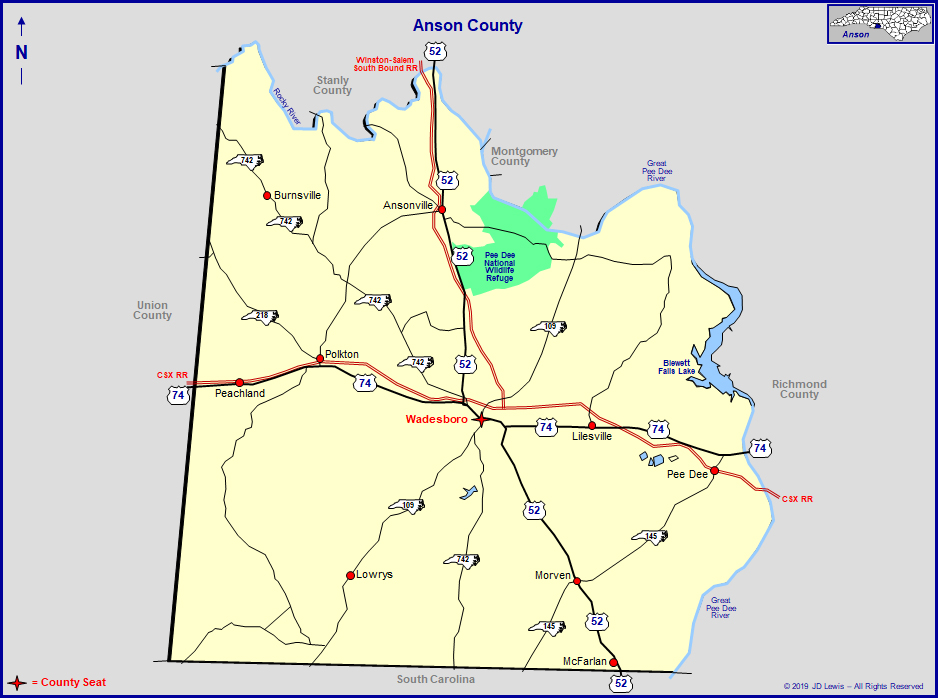 |
||||
|
|
||||
|
|
|
|
|
|
|
|
English Admiral |
|
|
|
|
|
|
|
|
|
|
|

|
|
|
|
|
|
|
|
|
|
|
|
|
|
|
|
|
|
|
|
|
|
|||
|
From 1755 to 1780, the county seat was called Anson Court House. In 1782-1783, laws were passed concerning the court house. In 1783, New Town was authorized to be established. In 1787, Newton, the county seat was changed to Wadesboro. Anson County Court House - Wadesboro, NC Anson County, once the largest in the state with a border on the Mississippi River, was carved from Bladen County in 1750. It was named for George Anson, 1st Baron Anson, a British admiral that circumnavigated the world. The first court house was built on the bank of the Pee Dee River at Mount Pleasant. Anson is a largely-rural area with 536 square miles. Located in the south-central region of North Carolina, the county is bordered by Richmond, Stanly, and Union counties, and Chesterfield County, SC. The county seat is Wadesboro. Ansonville was first settled in 1844. The settlement became Ansonville in 1857 and was incorporated in 1885. The town was the home of Carolina Female College (1850-1867), which was established by local planters and aided by Methodists. Several antebellum homes remain today. The Gaddy Wild Geese Refuge, which closed in 1957, was well known to nature lovers across the state. The Pee Dee National Wildlife Refuge is located south on U.S. Hwy. 52. Population: 636 Altitude: 324 feet. Although a post office was established in Lilesville as early as 1828, the town was not incorporated until 1874. The town is generally thought to be named after merchant Nelson P. Liles, although claims have been made in favor of Elijah Liles and Ephraim Liles. William Blewett purchased land along the Pee Dee River in 1758 where he operated a ferry and a fishery. In 1905, the Blewett Falls site was chosen for a hydroelectric power plant. Population: 459 Altitude: 474 feet. The town of McFarlan was named for Allan McFarland, president of the Cheraw and Salisbury Railroad, the 1900 Census dropped the 'd'. A post office was established in 1883 when the post office at Sneedsborough closed. The town was incorporated in 1885. John Grady of McFarlan served in the General Assembly in 1836; and, in 1928, Susan Braswell became one of the first female mayors in North Carolina. Population: 89 Altitude: 297 feet. A post office was established in 1823 and named for Morven, Scotland, the home of Esperon Cameron McKenzie, mother of Hugh McKenzie, the first postmaster. When the Cheraw and Salisbury Railroad came through, the settlement moved to its present site. The town was incorporated in 1883. In the War Between the States, Sherman's troops encamped at the plantation, Loch Adele. Yankee raiders burned most of old Morven. Population: 579 Altitude: 341 feet. Originally Mulcahy, the town of Peachland was renamed in 1888 for the peach orchards owned by Pad Gray. Peachland was incorporated in 1895. A Peachland physician, Dr. Parks Turner Beeman, is known for successfully feeding fever patients while other dotors preferred to starve them. His epitaph reads: "I Fed Fever." The area was once known for its gold-panning. In 1814, Lawyers Spring Primitive Baptist Church was started. Lawyers, on horseback from Charlotte to Wadesboro, camped at one of the many springs in the area. Population: 554 Altitude: 446 feet. Incorporated in 1875, Polkton is named for Leonidas Lafayette Polk, a state agricultrual leader who started Progressive Farmer. When the railroad came through the county, it passed through his farm. He envisioned the town being called Luneville. Journalist Harllee Branch Sr., who was city editor and a Washington correspondent with the Atlanta Journal, was from Polkton. He was chairman of the U.S. Civil Aeronautics Board. Population: 1,195 Altitude: 320 feet. |
|||
 |
 |
© 2022 - J.D. Lewis - PO Box 1188 - Little River, SC 29566 - All Rights Reserved